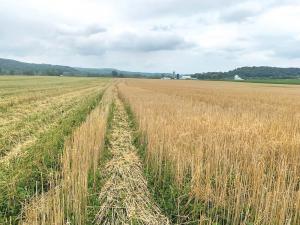2022 - Volume #46, Issue #3, Page #08
[ Sample Stories From This Issue | List of All Stories In This Issue | Print this story
| Read this issue]
New Markets Sought For Cereal Rye
 |
“We need more cash crops, and what else can you plant as late as rye in our northern states?” asks Zimmer. “You can drill it in after corn harvest as late as December and combine it by mid or late June.”
An increasing number of farmers plant rye as a cover crop in the fall, only to terminate it in the spring, either before or after planting corn or soybeans in the field. Zimmer suggests a different approach, letting it mature and selling the grain as a cash crop.
The fly in the ointment at this point is the limited demand for rye grain, other than for sale as a cover crop. Zimmer hopes to change that. The co-owner of Otter Creek Organic Farm, Zimmer is also the vice president of Rye Revival, a non-profit dedicated to promoting rye.
“We are promoting it as a food crop for bakers, brewers and distillers and as animal feed for poultry and livestock producers,” says Zimmer.
He points to Denmark, where antibiotics are not allowed in hog rations. Instead, they use rye for 80 percent of the hog ration.
“Their need for antibiotics seems to have gone away,” says Zimmer. “We’re also looking at it to replace 10 to 15 percent of the feed ration for chickens.”
Distillers are the largest market for rye at this point, but most rye has been imported from Russia and Ukraine.
Zimmer isn’t waiting around for buyers of his rye to appear. He is building a small-scale processing plant in a former cheese factory at the edge of his farm. It will include cleaning, separation for quality, and milling. His goal is to be able to process the rye, mill it and sell it by the tote.
“We hope to have it ready to go for our new crop,” says Zimmer. “We planted about 600 acres of rye this past fall at about 70 lbs. per acre.”
Most commercial-minded rye producers would plant at a 90-lb. rate. However, Zimmer has a dual purpose in mind. The first week of March, he frost-seeded a four-way clover mix at about 15 lbs. per acre. His lighter rye seeding rate reduces the likelihood that the rye will lodge or shade out the clover.
When he harvests in late June, he will flail-mow the straw and the knee-high clover. Later in the summer, he will spread manure and compost on the clover, flail mowing it again in late fall. Spring of 2023, he will plow the clover and straw residue under and plant organic corn.
Long term, Zimmer’s goal is to show other farmers how they can integrate a rye cash crop into their operations. “We don’t want to build a huge manufacturing plant,” says Zimmer. “We want to distribute the information so farmers can build their own.”
Contact: FARM SHOW Followup, Gary Zimmer, 3366 Cty. Rd. C, Avoca, Wis. 53506 (ph 608-269-6072; garyfzimmer@icloud.com) or Rye Revival (www.ryerevival.org; www.facebook.com/ryerevival.org).

Click here to download page story appeared in.

Click here to read entire issue
To read the rest of this story, download this issue below or click here to register with your account number.




